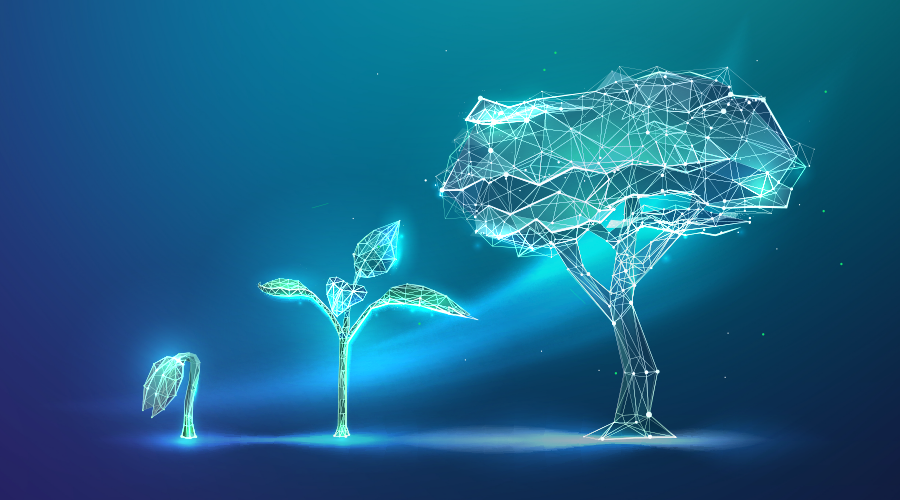The energy consumption of AI and the data that fuels this technology is staggering and, as we’ve seen so far in 2023, its development and deployment is accelerating quickly. Concerns grow that AI and the storage of quintillions of bytes of data generated daily could exacerbate the climate crisis.
AI will need to become green AI, where any emissions are managed to net zero levels, to prevent the technology becoming an environmental problem. If this happens, AI also has the potential to become a powerful climate solution, enabling sustainability for homes, cities, and industries.
ICT, AI, and Big Data’s Growing Contribution to Climate Change
2021 estimates of ICT’s contribution to global greenhouse gas emissions at 1.8-2.8% likely fell short of the true picture. Today’s emerging technologies like blockchain, AI, and quantum computing all use more power than any previous innovations and they are enabled by big data.
Engie puts data centre energy usage at around 4% of global electricity consumption and responsible for 1% of global greenhouse gas emissions. The data storage industry has an annual growth rate of 50%. And, in addition, the global AI market is forecast to grow by 40% each year. At these rates, resulting emissions could spiral out of control and experts warn the energy consumption of AI must be addressed immediately.
A research paper published in 2021 outlined that training ChatGPT, at that time, consumed the same amount of electricity as 120 homes would in a year. Another study, quoted by Deloitte, estimated that the electricity used in training a deep learning algorithm emitted 284 tonnes of CO2, five times the emissions of the average American car. Deploying AI in real-time applications consumes even more energy than training AI models. And once deployed, AI models must be constantly fed data to improve, thus creating an energy-consuming data processing cycle.
Sustainable Decision Makers Must Choose Green IT and Green AI
The first step to ensuring new technologies are sustainable is for developers to build with the goal of net zero emissions in mind and be transparent as to the energy consumption of the tools they create. Machine learning emissions calculators which take into account cloud providers, geographic regions, and hardware, are available on Github for engineers.
IT businesses, AI users, and data heavy firms have a responsibility to analyse emissions throughout their value chains and patronize energy efficient data centres, and suppliers that use them, to reduce carbon footprint. FinOps tools, developed to manage cloud billing, can help corporations to reduce their carbon footprint by limiting resource consumption. Software such as Salesforce’s Net Zero Cloud and Microsoft Cloud for Sustainability can provide visualizations of networks and processes that reveal issues and potential improvements.
Engie recommends that we “exit the classic scenario,” of data centres connected to national grids and water networks and look instead to independent microgrids where green data centre power is drawn from local renewable energy sources. In Montreal, Canada, there are already data centres that run purely on hydroelectricity.
When businesses choose an AI product, consideration must be paid to how sustainably its algorithms were developed right back to the roots of data storage practices. Technology supply chains must be investigated, where and how was an AI product developed? Where does the developer process and store data? Do they choose green data centres and manage their carbon emissions?
Companies, both suppliers and end-users, must also focus attention on reducing the storage of redundant data and how often data really needs to be transmitted. Data management processes should be designed to utilise the minimum amount of data and realise the relevance of data, archiving or purging irrelevant or outdated information.
Maker greener choices and deploying greener processes at every level forms part of AI ethics and the concept of digital sobriety that organisations must encompass on their journey to sustainability.
Could Green AI Achieve Net Zero Emissions?
Green AI has lower computational costs and reduced emissions, it’s a term used to refer to environmentally friendly AI that can play a leading role in creating sustainability. Orange puts data at the crux of how AI can help fight climate change. Imagine a factory that needs to reduce waste and emissions. If such an operation adds IoT devices and sensors throughout its processes, it can use AI and ML to track and optimise resources through a product’s lifecycle thus reducing energy consumption and carbon emissions. This adoption of AI and smart technology has the potential to reduce annual energy usage by 20%. What’s more, adding smart sensors and AI to any type of building to monitor and optimise temperature, water temperature, and lighting, can reduce energy use by up to 25%.
AI can be used at a micro level within homes, factories, and buildings. It has the potential to create efficient and sustainable supply chains and improve agricultural processes. On a global level green AI can generate data on deforestation and map changes in the oceans to empower the climate decisions of governments. AI can gather data from renewable energy sources, consumer data, and make predictions based on historic weather records to optimise electricity grids within nanoseconds.
Google UK’s DeepMind project already uses AI to optimise its wind farms and the company estimates the technology has propelled the value of the energy generated by one-fifth. Orange has built a software solution, MCO2, that will help companies assess the environmental impact of their businesses right from their telecoms usage to eventually throughout their product life cycle.
In the shipping industry, AI powered process mining software could stop an estimated 60 million containers being shipped empty each year because existing software cannot identify other orders to take-up unused capacity.
Indoor growers, Bowery Farming, utilise their BoweryOS to collect billions of data points from sensors and cameras. The system can identify a single unhappy plant or alert farmers to crops that need to be harvested. Machine learning algorithms are constantly working to identify the perfect crop “recipe,” and it’s this type of technology that may eventually sustainably feed the world’s growing population.
On the global scale, the UN Environment Program (UNEP) has a digital platform powered by AI. The World Environment Situation Room (WESR) visualizes earth observation and sensor data to analyse and predict the concentration of CO2 in the atmosphere and changes in the glaciers and global sea levels. UNEP says its goal for WESR is to be “a mission control centre for planet earth.”
The Opportunity of Green AI
The Paris Agreement of 2015 drives climate goals to stop rising global temperatures and to reach a status quo of net zero greenhouse gas emissions by 2030. Already, as per Gartner, nearly 50% of business leaders report that mitigating the effects of climate change is seriously impacting their operations.
Choosing green is now a necessity not an option, but it’s one that poses vast opportunity. Non-IT businesses can take advantage from being early sustainable leaders. Green AI companies can enable sustainability and achieve net zero goals whilst developing highly profitable applications. This profitability is illustrated by PwC estimates which say using AI for environmental solutions can contribute $5.2 trillion USD to the global economy in 2030 and at the same time reduce greenhouse gas emissions by 4%.
AI improves data analysis and forecasting by many magnitudes. Green AI produces insights that identify where energy is consumed, where emissions originate, and where efficiencies can be made.
Today and in the future, AI can optimise complex processes autonomously eliminating waste and reducing global emissions. However, this potential can be realised only if AI solutions, providers, and their data silos are built and operated sustainably from the outset.
The adoption of green AI, therefore, is a must for both product developers and technology users of any size. If you are looking to analyse the sustainability of your technology supply chains or to choose greener products to gain advantage through digital transformation, Ivy Partners can help.
Contact us to learn more about how you can adopt green AI for a more sustainable future in IT and artificial intelligence.

